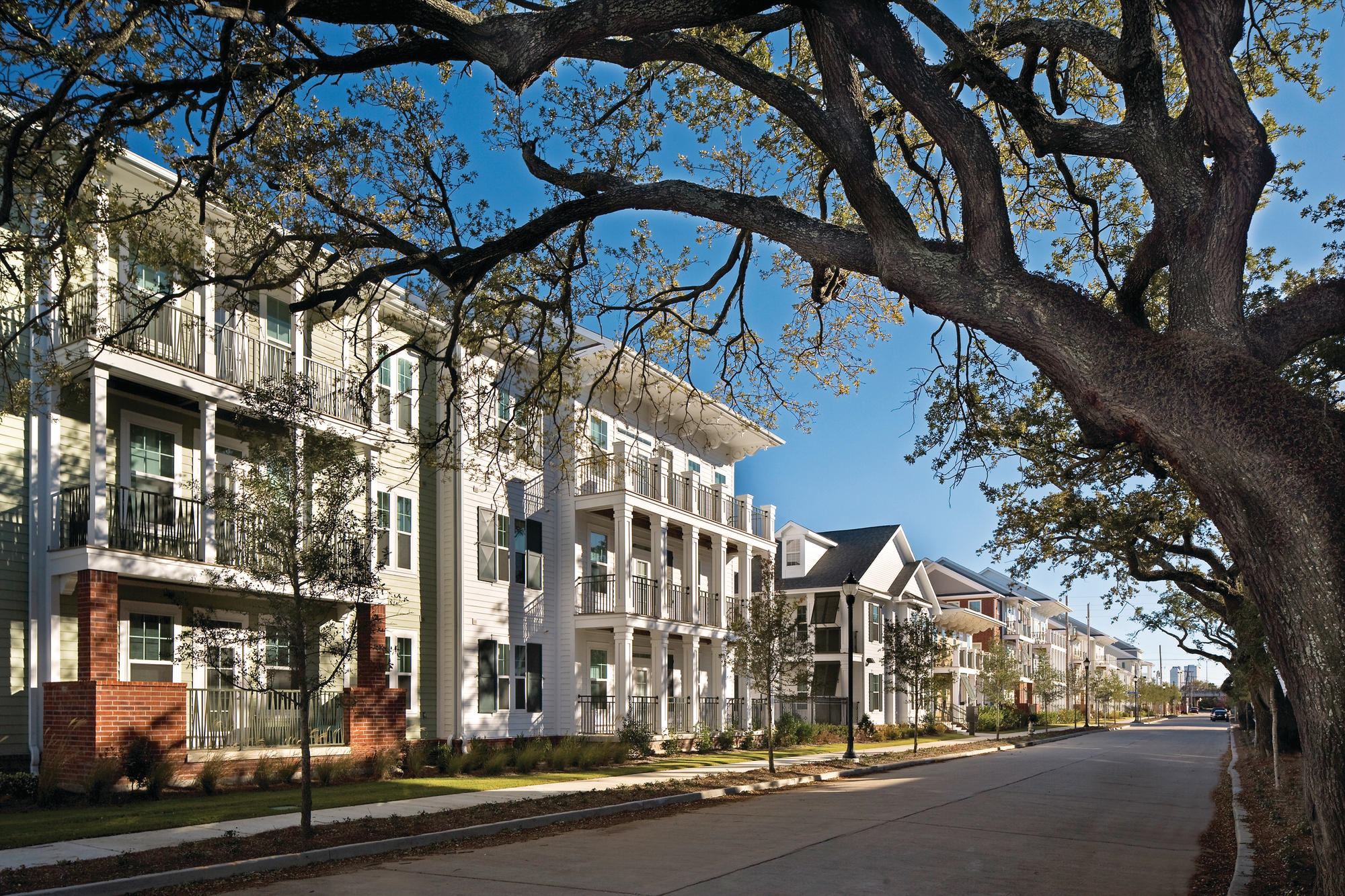Municipal or county zoning ordinances that offer incentives to developers/builders for including new housing units considered affordable to families with low to moderate incomes, as part of their subdivision. Inclusionary zoning counteracts practices that prevent affordable housing through a community’s zoning code (exclusionary zoning). Inclusionary zoning ordinances may also be written to require mandatory inclusion of affordable units.
Why is this important to your community?
The cost of housing impacts the quality of life of our residents, and households with low to moderate incomes are often forced to choose housing units that are below standards. The CONNECT Housing Needs Assessment found that 30% of the region’s households (282,624 households) had unmet housing needs. Unmet housing needs refers to overcrowding, incomplete facilities (e.g., plumbing, kitchen), and cost-burdened households spending more than 30% of income on housing costs. Nearly three-fourths of the households defined as having unmet housing needs had incomes of 80 percent of Area Median Income (AMI) or less. Such disparities in housing costs and income puts burden on households and impacts their way of life. However, according to a survey of the region’s municipalities, only 10% indicated that they had guidelines in place, such as inclusionary zoning, to encourage housing units priced at levels that many service workers or single-parent families could afford—people like police officers, starting teachers, day care workers, etc., in locations where they are most needed (near hospitals, major employment centers, schools, and transportation options) as well as throughout the community.
Households that have unmet housing needs are more likely to have difficulty affording necessities such as food, clothing, education, transportation, and medical care. Housing and transportation costs typically consume about half of the average household budget, but transportation costs are difficult to track and account for, depending on the relative accessibility of transportation to housing (http://locationaffordability.info/). Renters are particularly at risk, and renters with a severe cost burden are at risk of homelessness. Often, cost-burdened renters who experience one financial setback must choose between rent and food, or rent and health care for their families. Further, a family living in poor housing quality negatively impacts the parents’ stress levels and is a consistent predictor of emotional and behavioral problems in children and youth. As housing demand for rental and homeownership units continues to rise between now and 2050, private developers and local governments will need to work together to ensure that there is a diversity of housing types available for residents at all income levels.
Skip directly to
How Does It Work?
Resources
Using the Tool
Partners
Where Has It Worked?
Where is it appropriate to use?
What priorities does it address?
How does it work?
Goals of an inclusionary zoning ordinance or program are to create mixed-income neighborhoods, develop housing that is affordable for a diverse labor force and population, and increase homeownership opportunities and equity-building for low- and moderate-income households while not compromising the quality of housing units. This tool is most appropriate in communities that are experiencing significant growth now and anticipate future growth. Most ordinances set the percentage of affordable units at between 10% and 30% of overall housing units.
Communities may elect to use a voluntary approach which can be referred to as voluntary inclusionary zoning or incentive zoning. This approach encourages the private sector to develop mixed income housing (a mix of units at different price points in the same neighborhood or development project) by providing incentives for the inclusion of lower-priced housing units. Incentives can vary from density bonuses, expedited permit review, and reduced fees, to tax abatements.
Communities may also choose a mandatory inclusionary zoning approach that requires private sector developers to build a certain portion of a housing development for low- and moderate-income households. The mandatory approach is often the most effective way to increase the availability of housing for families at all price points. However, most mandatory inclusionary zoning ordinances build in some level of flexibility which could include applying the regulations to certain types or scales of development or allowing developers to pay a fee or build affordable units off site.
Resources
- CONNECT Housing Work Group – Comprehensive Regional Housing Strategy, Volume 1 Housing Needs Assessment & Volume 2 Regional AI and Fair Housing Equity Assessment
- Affordable Housing Ordinances / Flexible Provisions (Washington State, includes national links)
- Housing Policy.org – online guide to state and local housing policy
- Town of Davidson NC Mandatory Inclusionary Zoning
- Tennessee Housing Development Agency - Report on Incentives for the Development of Affordable Housing
- The HOMEConnecticut Program
- Minnesota Housing Partnership
- Smart Growth / Smart Energy Toolkit Massachusetts
- Center For Housing Policy – Inclusionary Housing
Ready to get started?
Using the Tool
- Understand existing municipal policies and ordinances related to workforce and moderate income housing in your community. What are the goals and polices included in your comprehensive plan? Review local housing strategies and reports.
- Clearly articulate the economic issues created when housing choice is limited. Work with hospitals, colleges, and other employers that rely on employees that may live below the median income, to craft this message.
- Convene a working group of policy makers, different housing providers, housing services, housing developers, and other partners such as organizations that are working to address unmet housing needs, to understand existing housing needs and consider development of an inclusionary zoning program. The specific terms of an inclusionary zoning policy or ordinance can vary by local needs.
- Consider holding educational / listening sessions with stakeholders and the public to understand existing housing needs in the community, and what will be needed in terms of design, landscaping, and other features to promote acceptance of inclusionary housing.
- Task the working group with drafting a set of proposed policies or an ordinance, including any incentives or density bonuses, to present before the Planning Commission/municipal governing board for review and approval.
- All ordinances should specify when and how the policy/ordinance is applied, including whether is it voluntary or mandatory, targeted income levels (e.g., 80% of Area Median Income or below), and the percentage of housing units to be defined as serving the targeted income levels.
- Determine what incentives are appropriate for your community. Flexible zoning and site plan options, such as density bonuses, setback and yard reductions, and/or reduced parking requirements may be appropriate and can be included as part of a voluntary inclusionary zoning ordinance. Other options include expedited plan review or a host of infrastructure based incentives.
- Harness the working group’s connections to a wider stakeholder group that can support and advocate the adoption of proposed policies or ordinances.
- Provide ongoing education and outreach to the community to promote understanding about housing, housing needs, and the housing market (and clientele) in the community.
- Monitor the number of low- to moderate-priced units proposed, built, and occupied. Update legislative bodies and the community on the successes of the ordinance or program.
Partners
- Community Development Organizations
- Community Service Providers
Where has it worked?
Voluntary Mixed Income Housing Development Program - Charlotte, NC
 Image Source: Creative Sources Photography.
Image Source: Creative Sources Photography.
Contact
Contact: Warren Wooten, City of Charlotte Neighborhood & Business Services Housing Division
twooten@ci.charlotte.nc.usAbout the Program
Charlotte City Council passed a zoning ordinance in 2013 incentivizing the development of mixed income housing to achieve a more diverse housing mix. The ordinance is applicable to targeted areas within neighborhoods having median home values above $153,000. Developers electing to follow the ordinance receive a density bonus of up to 3 units per acre in exchange for building at least 50% of the additional units as affordable. Affordable units are those units within the price range of buyers with incomes no more than 80% of the Area Median Income (AMI). Developers also receive reduced standards including smaller rear and front yard setbacks and are required to build affordable units that are architecturally similar to market-rate units within the development.
Why it works
The ordinance furthers the aims of both private developers and the City. Private developers now have a way to increase residential densities and potential profit without rezoning, while the City, by targeting specific areas, can ensure that areas with a dwindling or limited supply of affordable housing have a mix of affordable housing options. This ordinance is intended to ensure that residents have access to a diversity of housing and have more opportunities to age in place.
Three great features that characterize this ordinance are the requirements for quality landscaping and tree preservation, requirements to scatter affordable housing units throughout the development, and provisions keep some units permanently affordable.
http://charmeck.org/city/charlotte/planning/pages/voluntarymixedincomehousingdevelopmentprogram.aspx
Columbia Parc – national mixed-income housing model
http://www.nola.com/politics/index.ssf/2013/10/columbia_parc_showcased_as_nat.html
Montgomery County Inclusionary Zoning Program - Montgomery County, MD
About the Program
Montgomery County’s inclusionary zoning ordinance, adopted in 1973, was one of the first inclusionary zoning ordinances passed in the country and has served as a best practice model for communities throughout the country. Montgomery County is the second most densely developed jurisdiction in Maryland after Baltimore and has experienced steady growth over the past 20 year with over 95% of its land considered developed or conserved. The county is home to a number of government agencies and technology companies which has resulted in a strong and stable housing market. However, with 39% of the households in the county paying 30% or more of their income for housing, housing affordability for the county’s low- and moderate-income residents is a key issue. As demographics shift and the economy changes, the county has continually updated its inclusionary zoning ordinance to ensure that the program continues to require residential developments of a certain size to build 12.5 to 15% of units that are affordable for low- and moderate-income residents. The program aims to provide moderately priced housing and increase housing diversity by providing density bonuses (22% only when the number of affordable units exceeds the base requirement) and reducing other development costs for private developers. The ordinance is mandatory for residential developments of 20 units or more and voluntary for developments containing fewer units. Developers who wish to opt out of the program can pay a fee in lieu of building affordable units to the county’s Housing Initiative Fund (HIF).
Why it works
The ordinance has evolved over time to provide more options for developers while ensuring housing options exist for families at all price points. As a mandatory program that has been in effect for more than four decades, the process for building and selling affordable units is built into the housing development process for the county, simplifying the process for the county and developers alike. The program is considered successful and has produced more affordable housing units than any other inclusionary zoning program in the country. In the 35-year period between 1976 and 2011, the program helped to produce more than 13,000 units (9,300 for-sale and 4,000 rental units).
- Community Service Providers



